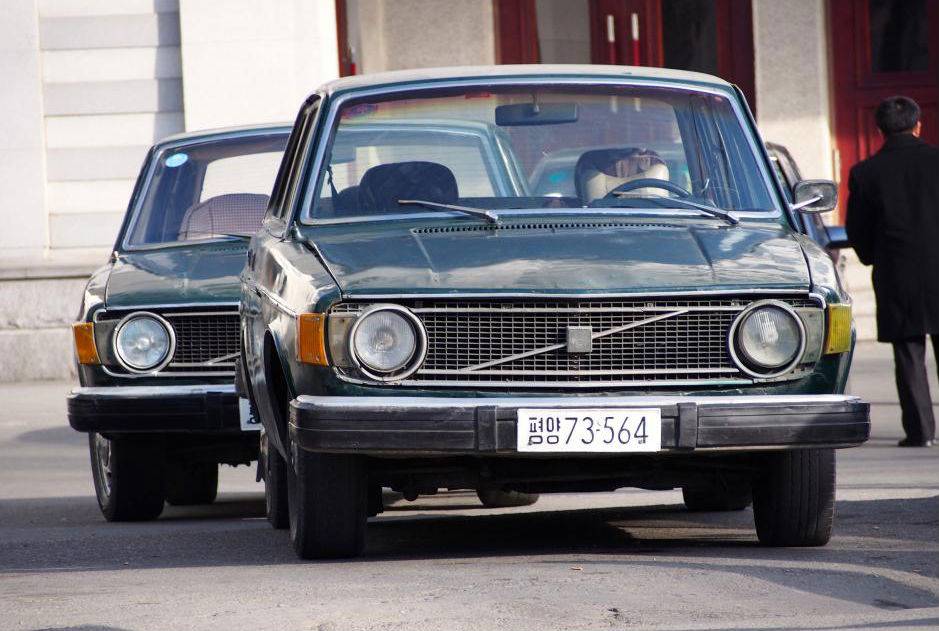Grand Theft Auto, Pyongyang

North Korea has been the focus of a good deal of news over the last few days, and it may be hard for those of us who are not subjects of repressive regimes to understand how different life is there, and how often international norms have been ignored by Kim Jong-un and his father and grandfather predecessors. The results aren’t always ones that put the world at risk of thermonuclear war, though; sometimes the news out of North Korea is mostly harmless. Still absurd, though.
For example, there’s that bill they keep ignoring — one for about $400 million from Sweden.
Pictured above are a pair of green Volvos, a model year from the early to mid-1970s. Volvos are reliable cars but you probably won’t find many of these on the road in the United States or anywhere else where there are Volvo dealerships; cars simply don’t last 30+ years in such economies. But North Korea’s economy isn’t a typical one, so, yes, you’ll see these relics sputtering around its roadways. And a lot of them, for that matter. There are about 1,000 of them, and that’s a lot for a country which generally eschews driving.
But: they’re not quite paid for.
In 1953, just after the end of the Korean War, North Korea’s economy was at its strongest. The next few decades proved relatively (relatively) peaceful and scandal-free, and Kim Il-sung sought to enter the landscape of international trade. In the 1970s, he found a partner in Sweden, who, as Newsweek explained, was well-suited to enter into a pact with Pyongyang: “local socialist groups wanted Sweden to formally recognize the new communist state, and businessmen wanted to exploit the region’s nascent mining industry.” The deal: Sweden was to send a fleet of 1,000 Volvos to North Korea, and North Korea would pay in various metals (copper, zinc, etc.) from their emerging mining industry. The Swedish government insured the Volvo corporation’s risk here — if North Korea didn’t pay up, Sweden would cover their losses.
And North Korea didn’t pay up.
It’s unclear why Kim Il-sung didn’t pay the bill. Maybe the metals that North Korean mined weren’t worth as much as they had hoped, or maybe they never mined enough of the metals at all. Perhaps Kim, an anti-capitalist, was making a political statement of sorts. Or maybe he just didn’t have a reason and figured hey, free cars! Regardless, North Korea had the Volvos and Sweden had bupkis to show for it. More than 40 years later, that’s still true.
Sweden hasn’t given up, though. Twice a year, they send North Korea a bill for the cars — one that keeps increasing to account for inflation and interest. As of 2014, per Newsweek, that came to a grand total of €300 million ($393 million), or a bit less than $400,000 per Volvo. As the cars are worth about $3,000 (in fair condition) each, that’s a pretty big price tag. But it’s really no matter — North Korea simply isn’t going to pay, and really, it’s not like Sweden is going to invade the Korean Peninsula over the debt.
We hope.
Bonus fact: The Grand Theft Auto video game series dates back to 1997 and has been a massive success since — the franchise has more than a dozen games and nearly 250 million total copies sold. And yet, it almost never happened. In 1995, the developers who would later make GTA had a different game called “Race’N’Chase” which, well, proved boring in playtesting — except for a bug, which caused computer-controlled police cars to go haywire, chasing down players with reckless abandon for safety. As GameFAQs summarized: “Suddenly, every chase was a life-or-death struggle against a psychotic army of suicidal police cruisers who would stop at nothing to turn your car into a twisted heap of burning scrap metal by any means possible. The playtesters started ignoring the missions and the dev team discovered that messing around in the open world was often more fun than following the game’s story. ” GTA, following that discovered model, came out not too long thereafter.
Double bonus!: With the release of Grand Theft Auto III in 2001, the franchise became a household name. It also adopted a new typeface for its logo, seen here, which the franchise has retained since. But that’s not a new font, as fans of daytime game shows are certain to notice. Grand Theft Auto uses the same typeface as The Price is Right.
From the Archives: Red Light, Green Light: The low-tech traffic lights of North Korea.
Related: GTA. Or for the less intense gamers, the 1974 home edition board game of The Price is Right.
